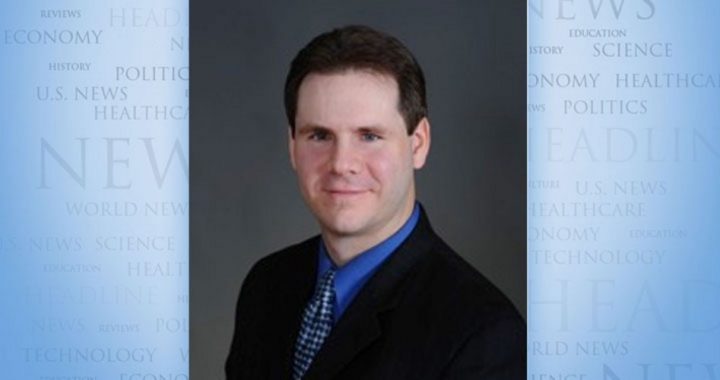
Hey, isn’t creating sacrilegious images brave? That’s what we heard years ago when at issue was “art” such as a crucifix immersed in a glass of urine or a Virgin Mary picture smeared with feces. But that wasn’t quite the response to pundit Pamela Geller’s Mohammed cartoon contest in Garland, Texas, was it?
Instead, after her affair was attacked by two AK-47-wielding Muslim jihadists, everywhere was the implication that she brought it on herself. As The New American’s Charles Scaliger reported, “New York Times foreign correspondent Rukmini Callimachi tweeted, ‘Free speech aside, why would anyone do something as provocative as hosting a ‘Muhammad drawing contest’?’” Donald Trump was likewise befuddled, asking, “What are they doing drawing Muhammad? Isn’t there something else they can draw? … They have to be in the middle of Texas and on Muhammad? … I don’t know, maybe she likes risk. What the h— is she doing?”
Of course, a fellow smart enough to make and lose and make untold millions of dollars ought to be able to figure it out. Agree or disagree with her methods, Geller appears to have two goals: to illustrate the problem of violence in Islam and to send a message that First Amendment rights won’t be stifled in deference to what is essentially a foreign faith. And let’s be clear on something: Geller is brave.
Not Andres Serrano, who immersed the crucifix in his own urine; not Chris Ofili, who created the dung-covered Virgin Mary. After all, the ominous message (allegedly from ISIS) Geller received after the Garland attack in which jihadis vowed, “We will send all our Lions to achieve her slaughter,” was far from the first death threat sent her way; this is why she long ago retained private security. And, as she told the Washington Post, “I knew what the stakes were when I started planning the cartoon contest. But it had to be done.… The jihadis had to be shown that at least some Americans will not bow to violent intimidation.” Moreover, unlike writer Salman Rushdie, who went into hiding after a fatwa was declared against him, Geller maintains her high profile, saying, “I will not live as a slave.”
As for being politically correct, political correctness is merely what we call the dominant set of social codes of our time. Adherence to it isn’t brave — it is the very thing protecting one from scorn, ostracism, career destruction, and danger. When so-called artists create anti-Christian works, they know they’ll be applauded in the media, may get government funding, and be called cutting edge. And when they receive a rebuke from, let’s say, the Catholic League, it just enhances their cachet.
So suffice it to say that we don’t exactly live in pious times; we live in hypocritical ones. Okay, a good percentage of our general population and virtually all our elites scoff at the notion of “sacred” Christian symbols. But should we then turn around and treat Muslim symbols as sacrosanct? For sure, the secular elites no more believe in Allah than the God of Abraham, but they certainly do treat Islam with more reverence, don’t they?
Note that this is nothing new in the post-West West. Hate-speech laws prevail in most of it, and it’s only our First Amendment preventing politically correct leftists from visiting them upon us Americans. These laws, mind you, parallel the double standard reflected in the Geller incident perfectly; they are simply codifications of the politically correct social codes (when a social code becomes prevalent enough, it’s often legislated). Speakers deemed “offensive” to “minority” groups are punished harshly, while minority tongues can lash out with relative impunity. This is especially obvious with respect to the Muslim-Christian dichotomy, as the reports here, here, and here evidence.
As the Charlie Hebdo massacre, the Garland incident, and many other events prove, one major difference between “offended” Christian and Muslim believers is that the former pray while the latter prey. One might thus conclude that Christians need to likewise be violent to inspire a tad more deference. But could you imagine the reaction if a couple of machine-gun wielding Christians attacked an anti-Christian exhibit? The media would lick their chops, castigating Christians for intolerance and hatefulness and, no doubt, bemoaning the violence engendered by “religion.” Parallels with the Crusades would surely be drawn, which would only prove my point: So intense is the double standard that the Crusades are portrayed as the epitome of Christian intolerance, when they actually were defensive campaigns designed to blunt Muslim aggression.
No one respects a coward, but fear is a base emotion entirely understandable. But our secular elites’ behavior is explained by something worse than cowardice alone: prejudice. Secular leftists don’t just tolerate strikes against Christianity, they relish them. They’re joyful when a Christian baker is put out of business for refusing to service a faux wedding, but say nothing when Muslim bakers act likewise. They cheer when the ACLU succeeds in forcing localities to remove a cross from public property, but don’t bat an eye at Islamic immersion programs in government schools. And they can’t use Jesus’ name in vain enough in their shows and films (the Swedish detective series Wallander is a particularly bad offender).
Then we have Geller. Harvard professor Noah Feldman clearly believes she’s “morally culpable” in the Garland violence because her actions were a “provocation”; in fact, he uses various forms of the word 14 times in a 913-word op-ed piece. But now consider what Mount Holyoke College art professor Michael Davis wrote in 1999 while defending the Madonna dung-smearer:
Chris Ofili’s collage is “shocking,” in that it is deliberately provocative and intends to jolt viewers into an expanded frame of reference, and perhaps even toward illumination. In this sense, it relates to the medieval aesthetic of ugliness in which visual dissonance and distortion were used in art to urge the viewer to move beyond the superficial material plane to a higher level of spiritual contemplation. [Emphasis added.]
Got that? When it’s done to Christians, it’s “illumination”; when done by Christians, it’s intolerance.
(Yes, I know Geller is Jewish, but most of her allies aren’t.)
Lastly note that urine-crucifix Serrano received more than $15,000 from the taxpayer-funded National Endowment for the Arts, and Ofili showed his work at the taxpayer-funded Brooklyn Art Museum. When Christians complained about these public dollars for private provokers, they were accused of stifling free expression. But when people use their own money to privately provoke Muslims, they’re told to shut the heck up — by elites who can’t understand why anyone would violate a certain fashionable double standard of our time.



